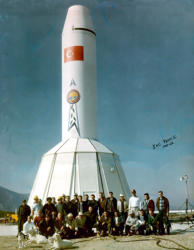HISTORY - Page 52
ABMA initially began work by screening potential materials and methods, and testing these materials with
jet burners. From this, they chose what seemed the best. Four protective methods were explored:
ablation, heat sink, radiation, and transpiration. Ablation proved promising, so an investigation of plastics,
fibers, and ceramics was started. To flight test the findings, three scaled-down models were constructed,
and the first was flown on the IRBM demonstration flight in September 1956. No recovery attempts were
made, but, according to telemetry data, the model functioned well. Recovery efforts were scheduled for
the Missile Number 34 shot in May 1957; however, the mission was not fulfilled because the REDSTONE
booster failed. Missile Number 40, fired in August, was completely successful, and the nose cone was
recovered close to the predicted impact range of 1,100 nm. Other shots were unnecessary, and the scaled-
model tests were concluded. The ablation principle had been proven
66
.
ABMA now began to work toward the full-scale nose cone re-entry Missile AM-5 launched on 18 May 1958
registered a re-entry success. Recovery of the full-scale nose cone in good condition by the Navy marked a
significant step forward in the state-of-the-art of this nation's long-range missile development programs.
Also interesting was the fact that re-entry was visible to on-site observers. This was followed by a July
firing—Missile AM-6—and recovery. The most famous of the re-entry tests, however, was JUPITER Missile
AM-18 fired on 18 May 1959. Contained within the nose cone were two primates, designated Able and
Baker, that survived their flight in excellent condition. Thus, not only was ABMA's ablative theory ably
demonstrated, but life could pass through outer space and be safely brought back to the earth
67
.
_____________________________







66. Rpt, Re-Entry Studies, 25 Nov 58, Vol I.
67. Ibid, Vol II.



Jupiter SM-78 Weapon System
I&C Team 2, Çigli AB, Turkey 1961-1962 Chrysler Corporation Missile Division

HISTORY - Page 52
ABMA initially began work by screening potential
materials and methods, and testing these materials
with jet burners. From this, they chose what seemed
the best. Four protective methods were explored:
ablation, heat sink, radiation, and transpiration.
Ablation proved promising, so an investigation of
plastics, fibers, and ceramics was started. To flight
test the findings, three scaled-down models were
constructed, and the first was flown on the IRBM
demonstration flight in September 1956. No recovery
attempts were made, but, according to telemetry data,
the model functioned well. Recovery efforts were
scheduled for the Missile Number 34 shot in May 1957;
however, the mission was not fulfilled because the
REDSTONE booster failed. Missile Number 40, fired in
August, was completely successful, and the nose cone
was recovered close to the predicted impact range of
1,100 nm. Other shots were unnecessary, and the
scaled-model tests were concluded. The ablation
principle had been proven
66
.
ABMA now began to work toward the full-scale nose
cone re-entry Missile AM-5 launched on 18 May 1958
registered a re-entry success. Recovery of the full-
scale nose cone in good condition by the Navy marked
a significant step forward in the state-of-the-art of this
nation's long-range missile development programs.
Also interesting was the fact that re-entry was visible
to on-site observers. This was followed by a July
firing—Missile AM-6—and recovery. The most famous
of the re-entry tests, however, was JUPITER Missile AM-
18 fired on 18 May 1959. Contained within the nose
cone were two primates, designated Able and Baker,
that survived their flight in excellent condition. Thus,
not only was ABMA's ablative theory ably
demonstrated, but life could pass through outer space
and be safely brought back to the earth
67
.
_____________________________
66. Rpt, Re-Entry Studies, 25 Nov 58, Vol I.
67. Ibid, Vol II.





















